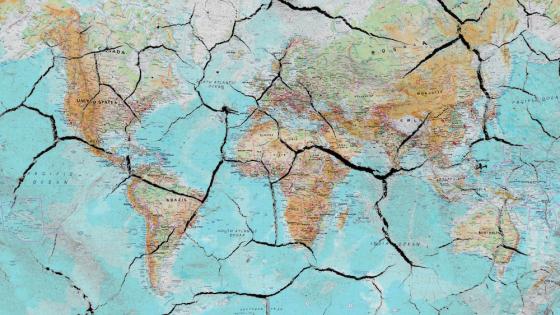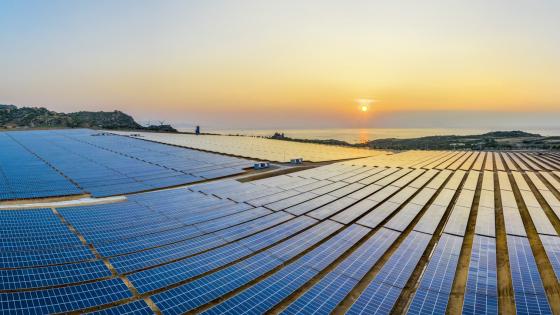Climate change is affecting, and will affect, the economic geography of the world in significant ways, from warmer climates that can disrupt production patterns and the quality of life across regions, to sea level-rise and the resulting flooding of coastal cities. These effects are, evidently, highly heterogenous across space. Warming negatively affects locations that are already uncomfortably warm, while it can potentially benefit some of the coldest places; flooding only affects coastal areas. This large spatial heterogeneity in the impact of climate change implies that, in order to understand and predict its overall economic cost, we need to understand its local economic impact and the redistribution of resources that it will generate across regions.
Most integrated assessment models (IAMs) used in the climate literature focus on the dynamic implications of climate change, but abstract from spatial heterogeneity and its implications (e.g. Nordhaus 2017, IPCC 2013). When they do include regions, there are only a few of them and the interactions of economic agents across space are extremely limited. As such, these models do not incorporate the impact that changes in the distribution of economic activity will have on the fortunes of particular locations, or the implications that these changes will have on aggregate effects.
In a recent paper (Cruz and Rossi-Hansberg 2021), we propose an IAM that incorporates high spatial resolution as well as a rich set of interactions between regions (the core of our model is based on the dynamic-spatial model of Desmet et al. 2018). Agents that are impacted by warmer temperatures adapt by moving, trading, altered fertility decisions, and, in the case of firms, by investing in alternative locations that benefit from (or are less impacted by) higher temperatures. Of course, it is important to recognise and incorporate that these forms of adaptation are costly, and therefore that agents use them only when their benefits exceed their costs. Ultimately, in a world in which climate change has many regions that lose but also some that gain, these spatial adaptation costs are an essential part of the effective cost of this phenomenon. Costless adaptation results in no cost, or even net benefits, of climate change, and impossible adaptation implies costs that are unrealistically high. As is almost always the case, reality is somewhere in between. The role of geographically detailed IAMs is to determine these costs somewhat more precisely. Any serious evaluation of policy requires us to do so.
A central component of the quantification of our model is the estimation of the effect of temperature on the fundamental amenities that make a location a desirable place to live, and the fundamental productivity that makes a location a good place to produce. Of course, part of the characteristics of a location as a place of residence or production is endogenous to the people that live there, the level of economic activity, and other endogenous components. Hence, it is important to first obtain ‘fundamental’ levels of these local amenities and productivities. We do so by matching the model to four cross-sections of the G-Econ data at the 1°x1° level. That is, we first obtain the local fundamentals and migration costs that make the model match exactly local population and income levels, as well as changes in population over time. With these measures in hand, we estimate the effect of temperature on these fundamental amenities and productivities in a flexible way that allows the semi-elasticity to depend on the level of temperature. We control for local natural features or regional fixed effects, as well as sub-national trends. The results are intuitive. A 1°C increase in temperature in the warmest places in the world lowers amenities by 5% and productivity by 15%. The effect is commensurate, but with opposite sign, for the coldest places. Although we are successful in measuring significant effects of increases in temperature in the regions with extreme climate, our estimates also showcase large uncertainty about the level of these damage functions. This uncertainty translates directly into uncertainty about the aggregate impact of global warming. Once we incorporate clean and fossil energy sources and a carbon cycle, the 95% confidence interval of the impact that global warming will have on economic outcomes by 2200 goes from 0% to 20%. In contrast, the spatial distribution of local impacts is fairly stable across damage function levels.
The effects of global warming on the spatial distribution of economic activity are large and worrying. As illustrated in Figure 1, while welfare in our baseline scenario can increase by as much as 15% in some regions of Canada and Siberia, areas in Central and South America (except for parts of Argentina and Chile), Central Africa, India, and South East Asia can suffer losses of between 10% and 15%. The distribution of the losses associated with global warming is bimodal both for welfare and for the present discounted value of real GDP. The losers are today’s poorest locations. Today’s richest regions are only marginally affected in our baseline.
Figure 1 Spatial impact on welfare of climate change
This unequal distribution of effects is not only unfair, given that the source of this phenomenon are global carbon emissions, but embeds large migrations of people and innovation to the North. Indeed, our findings show that migration, and to a lesser extent investment in local technological improvements, are important adaptation mechanisms. Trade, in contrast, is less relevant. This is natural, as trade declines rapidly with distance and temperature changes are highly spatially correlated. Of course, if climate change affects local sectoral specialisation, an effect that we abstract from in this study, it can play a larger role (see Desmet and Rossi-Hansberg 2015, Nath 2020, and Conte et al. 2020 for papers that incorporate this mechanism).
As for policy, the role of carbon taxes or clean energy subsidies is also governed by spatial heterogeneity and adaptation mechanisms across locations. Carbon taxes, for example, improve many of the regions most affected by global warming and have the potential of lowering temperatures significantly over hundreds of years. However, absent other innovations in abatement technologies, they mostly delay – rather than eliminate – the use of carbon. The reason is that fossil fuel extraction costs are convex in the amount of carbon that has been exploited in the world. Thus, if a global carbon tax leads to less fossil fuel use today, it also implies a lower carbon price in the future. The implication is that carbon taxes ‘flatten’ the temperature curve, but do not eliminate the long-run temperature changes that arise from the ultimate depletion of carbon resources on Earth. The resulting gains from the policy are, therefore, relatively small. Delaying carbon emissions with carbon taxes is much more useful when an abatement technology, ‘a cure’, is forthcoming.
The large heterogenous impacts of climate change across regions is a first-order characteristic of one of the most important phenomena faced by humankind. It's time to incorporate it fully in the set of models and tools that are used to predict the economic effects of climate change and make the appropriate policy recommendations.
References
Cruz, J L, and E Rossi-Hansberg (2021), “The Economic Geography of Global Warming”, CEPR Discussion Paper 15803.
Desmet, K, D K Nagy, and E Rossi-Hansberg (2018), “The Geography of Development”, Journal of Political Economy, 126 (3), 903–983.
Desmet, K, and E Rossi-Hansberg (2015), “On the spatial economic impact of global warming”, Journal of Urban Economics, 88 (C), 16–37.
Nath, I (2020), “The food problem and the aggregate productivity consequences of climate change”, working paper.
Conte, B, K Desmet, D K Nagy, and E Rossi-Hansberg (2020), “Local Sectoral Specialization in a Warming World”, CEPR Discussion Paper 15491.
Nordhaus, W D (2017), “Revisiting the social cost of carbon”, Proceedings of the National Academy of Sciences, 114 (7),1518–1523.
IPCC (2013), Climate change 2013: The physical science basis, Cambridge University Press.




